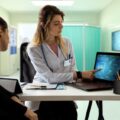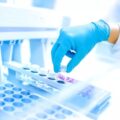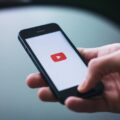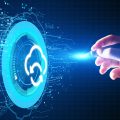
The advancement of technology is having a significant impact on the field of nursing. From telehealth to robotic surgery, the world of nursing is undergoing a revolutionary transformation due to the introduction of new technologies.
Technology has been a driving force in revolutionizing many aspects of our lives, and the nursing field is no different. We have seen tremendous advancements in the past few decades that have significantly improved healthcare and patient care.
From electronic health records and virtual visits to telemedicine and robotics, technology is changing the face of nursing. Below, we discuss the various ways that technology is changing how nurses practice and interact with their patients, as well as the potential implications that this could have on the future of healthcare.
Overview of how technology is impacting nursing
Technology is changing the world of nursing, and its benefits to nurses and their patients are exponential. Nurses and all practitioners must adjust to the new technological advancements to reap the benefits and improve patient care. Nurses must gain training in these technological advancements to enhance patients’ care and safety.
You may be wondering, is nursing a good career? Even though nursing can be a fulfilling career choice in more ways than one, this does not mean that it is a good career for everyone. Holy Family University offers the best platform for high education, providing an online course that allows for self-scheduling with significant control and input into your final schedule.
Electronic health records
Electronic health records (EHRs) have transformed the way that nursing professionals track their patients’ medical histories. These digital records can be accessed from anywhere and at any time, making it easier for nurses to share information with other healthcare providers and improve patient outcomes.
When patient data is recorded in an electronic system, it can be cross-checked with other information, reducing the risk of incorrect or incomplete information being used to make medical decisions. In addition, EHRs can help nurses keep track of medication lists, allergies and other vital health information that can be used to guide care decisions.
EHRs can help nurses and other professionals coordinate care more effectively and provide better support for their patients by providing real-time access to patient data. Nurses must be properly trained to use these systems and understand their limitations, and there are concerns about the security and privacy of patient data.
Wearable devices
Wearable devices worn on the body provide real-time health data and analytics that nurses can use to monitor and track patient progress. Wearable technology can come in many forms, including smartwatches, fitness trackers and medical devices such as insulin pumps.
Nurses can receive alerts if a patient’s vital signs, such as heart rate or blood pressure, become abnormal, allowing them to respond quickly and potentially prevent a medical emergency. Wearable devices make it easier for patients to take a more active role in their care by monitoring their health and sharing data with healthcare providers.
With wearable devices, nurses can collect and analyze patient data over time to identify patterns or trends indicating a potential health problem. By doing so, nurses can take a proactive approach to care and potentially prevent hospitalizations or readmissions.
While wearable devices have shown great promise in nursing, there are still some challenges to consider. Privacy concerns and data security are two major issues when using wearable technology. Nurses need to ensure that patients are fully informed about the data that is being collected and how it will be used.
Telehealth
Telehealth is an increasingly popular way to provide healthcare services, and is significantly impacting nursing. This can include videoconferencing with patients, virtual check-ins, remote monitoring and more.
Telehealth can help improve access to healthcare services, particularly in rural or remote areas with limited access to medical professionals. By using telehealth, nurses can reach patients virtually, reducing the need for travel or face-to-face visits.
Nurses can monitor patients remotely, track their progress and adjust their treatment plans as needed, all without needing a physical office visit. This can save time, reduce costs and improve patient satisfaction.
Telehealth can also be beneficial for nurses themselves. Many nurses struggle with burnout or overwork, but telehealth can help alleviate some of these issues by allowing nurses to work remotely. This can give nurses more flexibility in their schedules and allow them to take better care of themselves, ultimately benefiting their patients.
Telehealth faces the need for strong technological infrastructure and resources. Not all healthcare facilities have the necessary equipment or support to implement telehealth services effectively.
Nursing informatics
Nursing informatics uses data and information systems to support nursing processes, facilitate communication and collaboration, and improve patient outcomes. Nursing informatics tools and technologies can help nurses gather and analyze patient data, track clinical outcomes, and manage and communicate patient care plans.
Nursing informatics tools can also help nurses identify and monitor patterns and trends in patient data and use that information to make informed decisions about patient care. The most common nursing informatics tools include EHRs, nursing-specific documentation systems, clinical decision support systems (CDSS) and telehealth platforms.
EHRs allow nurses to access patients’ medical histories, track their current medications and treatments, and document their care plans and progress in real time. This information can then be shared with other healthcare providers, improving coordination and communication across the healthcare team.
CDSS and nursing-specific documentation systems are also valuable nursing informatics tools. CDSS can help nurses identify potential drug interactions, alert them to possible complications or adverse events, and provide evidence-based clinical guidance. On the other hand, nursing-specific documentation systems can help nurses document and track patient care plans, monitor vital signs and manage patient charts.
Nursing informatics allows the safe flow of medical information through authorized healthcare providers keeping track of individual information, enabling providers to have a clear path in treating medical emergencies. For instance, a patient having a medical emergency may be allergic to certain medication, and informatics makes this information available.
Natural language processing
Natural language processing (NLP) is used in nursing through chatbots and virtual assistants. These tools can help nurses respond faster and more accurately to patient inquiries.
Patients can chat with a virtual assistant to get answers to questions about their medication, their symptoms or their treatment plan. This can save time for nurses, who can focus on more complex tasks that require their attention.
NLP is also being used to analyze patient data and identify patterns that may indicate a need for intervention. For example, if a patient shows signs of depression, NLP can analyze their social media posts and other online activity to identify risk factors. This can help nurses provide early interventions to prevent further complications.
Robotics
Robots can help with various tasks, from transporting medical equipment to aiding patients in daily routines. They can help monitor patients’ vital signs, administer medications and perform surgical procedures.
An exciting application of robotics in nursing is the development of robotic exoskeletons that can help to provide support and mobility to patients with mobility impairments. These exoskeletons can assist with walking and even allow for more independence and a better quality of life for patients who may otherwise require constant assistance.
Robots can also play a crucial role in disinfection and cleaning protocols. In the era of COVID-19, healthcare facilities explored ways to keep patients safe and reduce the risk of infection transmission. UV disinfection robots are being used to disinfect rooms and equipment, and some facilities are exploring using drones to deliver medical supplies and equipment.
3D printing
3D printing technology allows nurses to create three-dimensional models of medical devices and prosthetics. In nursing, 3D printing has numerous applications, such as creating customized braces, splints and implants. 3D printing is especially useful for patients who need prosthetic limbs as they can be custom-made to fit the patient perfectly.
Furthermore, 3D printing can also create anatomical models to aid in surgical procedures. Nurses can use these models to visualize the patient’s anatomy in 3D and plan the surgery more accurately, which can help to improve surgical outcomes.
3D printing is a valuable tool in medical research, as the technology enables nurses to use it to create replicas of cells and organs, which are studied for disease research. This technology can also help drug discovery by testing the effectiveness of drugs on 3D-printed cells and organs.
Blockchain
Blockchain, a decentralized system of records, ensures data security and integrity, making it an attractive tool for healthcare professionals, including nurses.
In healthcare, blockchain technology can securely store patient information, including medical history, lab results and treatment plans. By using blockchain technology, the records are protected from being lost or tampered with, which reduces the risk of medical errors.
Nurses can also benefit from blockchain technology when tracking medications and supplies. Using a blockchain system, a nurse can quickly scan a medication or supply and have it added to the ledger, where it is easily accessible by all members of the care team. This ensures that everyone is up to date on the status of a patient’s care, which can ultimately lead to better outcomes.
Blockchain can also improve patient privacy by allowing for secure communication and data sharing. Nurses can securely, reliably and transparently share information with other healthcare providers.
Virtual reality
Virtual reality (VR) is a technology that immerses users in a computer-generated environment. In the world of nursing, VR can provide unique opportunities for training and education.
Nursing students can experience realistic scenarios without the risk of harm to patients. They can also learn to manage their stress and emotions in high-pressure situations, such as emergencies or surgeries.
VR can also benefit patients by providing a way to manage pain, anxiety and other symptoms. By wearing VR headsets, patients can escape to peaceful virtual environments or distract themselves during uncomfortable procedures.
Some hospitals even use VR to simulate medical procedures for children, making the experience less scary and more engaging. As technology advances and becomes more accessible, we can expect to see even more applications for virtual reality in healthcare.
Artificial intelligence
Artificial intelligence (AI) systems are becoming increasingly sophisticated, and they have the potential to revolutionize patient care in once-impossible ways. AI-powered technology can help nurses automate routine tasks, such as scheduling appointments or keeping track of medical records.
One of the most promising applications of AI in nursing is using machine learning algorithms to analyze patient data and identify potential health risks. AI systems can sift through massive amounts of patient data and help nurses make better decisions about patient care. This can lead to earlier diagnoses, more personalized treatment plans and better patient outcomes.
AI-powered technology can also help nurses detect potential complications before they become serious. For example, smart sensors can monitor patients’ vital signs and alert nurses if abnormalities are detected. This allows nurses to intervene early and prevent potentially life-threatening complications.
Despite the many benefits of AI in nursing, there are also ethical considerations to consider. For example, nurses must be mindful of privacy concerns when using AI-powered tools to collect and analyze patient data. Additionally, there is always the risk of AI bias, leading to unequal patient treatment based on race, gender or other factors.
Improving patient education through digital technology
Traditionally, nurses were the primary source of patient education in hospitals. However, with the rise of digital technology, patients can now access information about their health online.
Digital technology has allowed nurses to enhance patient education through various platforms such as videos, blogs and websites. Patients can access this information at any time, from any place, making managing their health easier.
Digital technology has enabled nurses to create interactive and engaging educational materials for patients. For example, videos that explain medical procedures or medication regimens can be shared with patients to help them understand the process better. Nurses can also use online health communities to connect with patients, providing a platform for patients to ask questions and share their experiences with others.
Furthermore, digital technology has enabled nurses to reach out to patients who cannot attend in-person education sessions. For instance, patients in remote areas or those with mobility issues can access health information online.
Digital technology also allows nurses to provide patients with educational materials in multiple languages, catering to the diverse populations that exist in healthcare. Digital technology also lets nurses track patients’ health information in real time.
By using wearable devices such as smartwatches or fitness trackers, patients can track their health information, such as their heart rate or blood sugar levels. Nurses can monitor this information remotely, providing personalized education based on collected data. Patients can then make more informed decisions about their health, leading to better health outcomes.
Ethical considerations in the use of technology in nursing
As technology advances, nurses must also consider the ethical implications of using new tools and methods in their daily practice. With EHRs, telehealth and wearable devices becoming increasingly common in healthcare settings, nurses must be aware of potential ethical dilemmas.
One of the biggest concerns is patient privacy and confidentiality. EHRs contain a wealth of sensitive information, and nurses must follow strict access and sharing protocols. This includes protecting passwords and logins, verifying the identity of individuals requesting information, and only sharing information on a need-to-know basis.
Another ethical consideration is the potential for bias and discrimination in algorithms used for decision-making. AI and machine learning are increasingly used in healthcare, but ensuring that these tools are designed and programmed to be fair and unbiased is important. Nurses must be aware of potential biases and advocate for the ethical use of these tools.
Furthermore, telehealth raises ethical issues surrounding the quality of care and the responsibility of nurses in virtual consultations. Nurses must maintain the same professionalism and care in virtual consultations as in face-to-face interactions. Nurses must also ensure that patients have the technology and resources to participate in telehealth consultations.
Nurses must consider the potential impact of technology on their practice and the profession as a whole. Technology can help improve efficiency and accuracy, but can also lead to dehumanization and the loss of interpersonal connections with patients. Nurses must balance using technology to enhance patient care with maintaining the human touch that’s essential to nursing.
Industry transformation
Technology is transforming the nursing industry in significant ways. The benefits of technology are clear, from EHRs and wearable devices to AI and telehealth.
These advancements have improved the efficiency and accuracy of healthcare delivery and made it possible to personalize and tailor care to each patient’s unique needs. While there are ethical considerations to remember when using technology, it is clear that it is shaping the future of nursing.
Nurses who stay current with technological trends will undoubtedly provide the best care for their patients, while contributing to a safer, more efficient healthcare system overall. With the right training and education, nurses can utilize these advancements to deliver high-quality patient care, ultimately improving patient outcomes and creating a more patient-centered healthcare system.







